The concept of the glycaemic index was first instigated by Dr. David Jenkins, a professor in nutrition at the University of Toronto, Canada in 1981. Initially it was used to help diabetics to control their blood sugar, but later its relevance to weight management and sporting performance became apparent.
The glycaemic index (GI) is a ranking of a food based on its immediate effect on blood sugar levels. All foods are compared to pure glucose, which has a GI of 100 and are tested in equivalent carbohydrate amounts. In other words, every food portion that is tested contains 50 grams of carbohydrate (Jelly Beans (60g) = 50g carbohydrate: White bread (100g) = 50g carbohydrate).
The quicker the blood sugar response, the higher the GI and obviously the slower the response the lower the GI. Traditionally it was assumed that all starchy non-sweet foods had a low GI and all sugary simple carbohydrates had a high GI, but research has demonstrated that this isn’t the case. For instance a jacket potato (starchy) has a GI of 93, almost as high as glucose, compared with apples (38), Banana (55) and even chocolate (49). Take a look at the table below to get an idea of the GI in various common foods:
Information source: The Glucose Revolution: Brand-Miller, Wolever, Colagiuri and Foster-Powell (1999).
GI and fat-loss
If you want to lose body fat, a diet low in fat and high in low GI carbohydrates will help you to do this. A high GI carbohydrate will stimulate over production of insulin, which results in some of the carbohydrate you’ve eaten being stored away as fat. The body will fight to lower blood glucose levels to within the normal range and will overcompensate slightly, leaving blood glucose levels lower than normal. This leads to sleepiness, because the brain is almost entirely dependent on blood glucose for energy, as well as hunger pangs, which can result in over-eating.
A low GI food will drip-feed carbohydrate into your bloodstream over a prolonged period of time encouraging a gentle release of insulin, discouraging fat storage (the body uses what it’s getting as it gets it) and maintaining a steady supply glucose to the brain (so you feel alert). Low GI foods also have a higher satiety level too, so you’re less prone to over eat, which has obvious benefits to the person wanting to lose body fat.
Be aware that some low/moderate GI foods also contain a lot of fat, so don’t be mislead by the relatively low GI of things like chocolate (49). You should be aiming for low fat and low GI foods like baked beans, lentils, chickpeas, pasta, basmati rice, wholemeal bread, fruit (fresh and dried) and low-fat sweetened yoghurts. A fruit yoghurt with banana chopped up in it is a useful alternative to chocolate and cakes!
GI and performance
Whilst low GI foods should represent the mainstay of your performance diet, it’s wise to consume foods with a moderate to high GI whilst you’re exercising so that you can get hold of the energy quickly. Also, high GI foods tend to be less bulky on the whole, so are an efficient way of getting the calories in. This is why sports drinks are so useful as they contain man-made low-bulk glucose polymer, which possesses high glycaemic index characteristics, yet at the same time releases energy over a prolonged period of time. Glucose polymer, or maltodextrin, comes in many different forms though depending on the number of glucose molecules it’s manufactured to contain, so make sure you get it from a reliable source (you want a DE (dextrose equivalent) value of around 18-20 (that’s 18 to 20 glucose molecules per polymer). Some maltodextrins are composed of a chain of only a few glucose molecules, which not only empty from the stomach less quickly, but also supply less total glucose to your blood. If you’re interested in purchasing a hefty serving of long-chain glucose polymer, click here and take a look at our 10kg tub of TORQ energy.
As soon as you’ve finished exercising you should opt for high GI foods as these have been found to encourage glycogen storage, because due to their nature they get into the bloodstream quickly. This is where the jacket potato is useful! Look at the list of foods above to get an idea of what else you should be eating.
Before exercise or competition you should go for low GI foods, because these make energy available long after you’ve consumed them. A low GI food will be slowly released from the small intestine during exercise, even if it has been consumed quite some time beforehand. A good pre-exercise breakfast would be something like porridge or beans on toast (whole grain bread).
TORQ bar is an energy food currently under development which is being carefully formulated to ensure a balanced mixture of high and low GI ingredients. This means that whilst some of the ingredients will quickly enter the blood stream, others will drip-feed in long after the energy from the early ingredients has been used. This also makes the bar appropriate for use before, during or after exercise.
I’ll keep you posted on TORQ bar’s launch, but they should be available soon after Christmas – keep checking the site.







